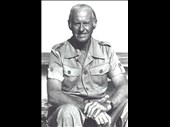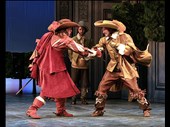Solution for: The Horton Castle site
Answer Table
| 1. C | 6. F |
| 2. E | 7. A |
| 3. H | 8. C |
| 4. B | 9. B |
| 5. A | 10. B |
Exam Review
The Horton Castle site

|
NATALIE: |
Dave, I’m worried about our case study. I’ve done a bit of reading, but I’m not sure what’s involved in actually writing a case study - I missed the lecture where Dr Baker talked us through it. |
|
DAVE: |
OK, well it’s quite straightforward. We’ve got our focus - that’s tourism at the Horton Castle site. And you said you’d done some reading about it. |
|
NATALIE: |
Yes, I found some articles and made notes of the main points. |
|
DAVE: |
Did you remember to keep a record of where you got the information from? |
|
NATALIE: |
Sure. I know what a pain it is when you forget that. |
|
DAVE: |
OK, so we can compare what we’ve read. Then we have to decide on a particular problem or need at our site. And then think about who we’re going to interview to get more information. |
|
NATALIE: |
OK. So who’d that be? The people who work there? And presumably some of the tourists too? |
|
DAVE: |
Yes, both those groups. So we’ll have to go to the site to do that, I suppose. But we might also do some of our interviewed away from the site - we could even contact some people here in the city, like administrators involved in overseeing tourism. |
|
NATALIE: |
OK. So we’ll need to think about our interview questions and fix times and places for the meetings. It’s all going to take a lot of time. |
|
DAVE: |
Mmm. And if we can, we should ask our interviewees if they can bring along some numerical data that we can add to support our findings. |
|
NATALIE: |
And photographs? |
|
DAVE: |
I think we have plenty of those already. But Dr Baker also said we have to establish with our interviewees whether we can identify them in our case study. or whether they want to be anonymous. |
|
NATALIE: |
Oh, I wouldn’t have thought of that. OK, once we’ve got all this information, I suppose we have to analyse it. |
|
DAVE: |
Yes, put it all together and choose what’s relevant to the problem we’re focusing on. and analyse that carefully to find out if we can identify any trends or regularities there. That’s the main thing at this stage, rather than concentrating on details or lots of facts. |
|
NATALIE: |
OK. And then once we’ve analysed that, what next? |
|
DAVE: |
Well, then we need to think about what we do with the data we’ve selected to make it as clear as possible to our readers. Thing like graphs, or tables, or charts. |
|
NATALIE: |
Right. |
|
DAVE: |
Then the case study itself is mostly quite standard; we begin by presenting the problem, and giving some background, then go through the main sections, but the thing that surprised me is that in a normal report we’d end with some suggestions to deal with the problem or need we identified, but in a case study we end up with a question or a series of questions to our readers, and they decide what ought to be done. |
|
NATALIE: |
Oh, I hadn’t realised that. |
|
NATALIE: |
So basically, the problem we’re addressing in our case study of the Horton Castle site is why so few tourists are visiting it. And we’ll find out more from our interviews, but I did find one report on the internet that suggested that one reason might be because as far as transport goes, access is difficult. |
|
DAVE: |
I read that too, but that report was actually written ten years ago, when the road there was really bad. but that’s been improved now. And I think there’s plenty of fascinating stuff there for a really good day out. but you’d never realise it from the castle website - maybe that’s the problem. |
|
NATALIE: |
Yes. it’s really dry and boring. |
|
DAVE: |
I read somewhere a suggestion that what the castle needs is a visitor centre. So we could have a look for some information about that on the internet. What would we need to know? |
|
NATALIE: |
Well, who’d use it for a start. It’d be good to know what categories the visitors fell into too, like school parties or retired people, but I think we’d have to talk to staff to get that information. |
|
DAVE: |
OK. And as we’re thinking of suggesting a visitor centre we’d also have to look at potential problems. I mean, obviously it wouldn’t be cheap to set up. |
|
NATALIE: |
No. but it could be a really good investment. And as it’s on a historical site it’d need to get special planning permission. I expect. That might be hard. |
|
DAVE: |
Right, especially as the only possible place for it would be at the entrance, and that’s right in front of the castle. |
|
NATALIE: |
Mmm. |
|
DAVE: |
But it could be a good thing for the town of Horton. At present it’s a bit of a ghost town. Once they’ve left school and got any skills or qualifications, the young people all get out as fast as they can to get jobs in the city. and the only people left are children and those who’ve retired. |
|
NATALIE: |
Right. Something else we could investigate would be the potential damage that tourists might cause to the castle site, I mean their environmental impact. At present the tourists can just wander round wherever they want, but if numbers increase, there might have to be some restrictions, like sticking to marked ways. And there’d need to be guides and wardens around to make sure these were enforced. |
|
DAVE: |
Yes, we could look at that too. OK, well ... |
Questions 1-6
Complete the flow-chart below.
Choose SIX answers from the box and write the correct letter, A-H, next to Questions 1-6.
|
A |
patterns |
B |
names |
C |
sources |
D |
questions |
|
E |
employees |
F |
solutions |
G |
headings |
H |
officials |
STAGES IN DOING A TOURISM CASE STUDY
|
RESEARCH Locate and read relevant articles, noting key information and also 1 Identify a problem or need Select interviewees - these may be site 2 , visitors or city 3 Prepare and carry out interviews. If possible, collect statistics. Check whether 4 of interviewees can be used |
↓ |
|
ANALYSIS Select relevant information and try to identify 5 Decide on the best form of visuals |
↓ |
|
WRITING THE CASE STUDY Give some background before writing the main sections Do NOT end with 6 |
Questions 7-10
Choose the correct letter, A, B or C.
The Horton Castle site
7 Natalie and Dave agree one reason why so few people visit Horton Castle is that
A the publicity is poor.
B it is difficult to get to.
C there is little there of interest.
7. Answer: A Locate Listen from here
8 Natalie and Dave agree that the greatest problem with a visitor centre could be
A covering the investment costs.
B finding a big enough space for it.
C dealing with planning restrictions.
8. Answer: C Locate Listen from here
9 What does Dave say about conditions in the town of Horton?
A There is a lot of unemployment.
B There are few people of working age.
C There are opportunities for skilled workers.
9. Answer: B Locate Listen from here
10 According to Natalie, one way to prevent damage to the castle site would be to
A insist visitors have a guide.
B make visitors keep to the paths.
C limit visitor numbers.
10. Answer: B Locate Listen from here
Other Tests
-
Total questions: 10
- 10- Summary, form completion
-
Total questions: 10
- 4- Multiple Choice
- 6- Sentence Completion
-
Total questions: 10
- 10- Summary, form completion
-
Total questions: 10
- 6- Matching
- 4- Summary, form completion
-
Total questions: 10
- 10- Summary, form completion
-
Total questions: 10
- 10- Summary, form completion











